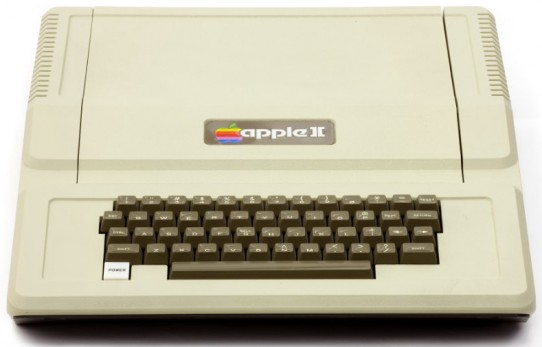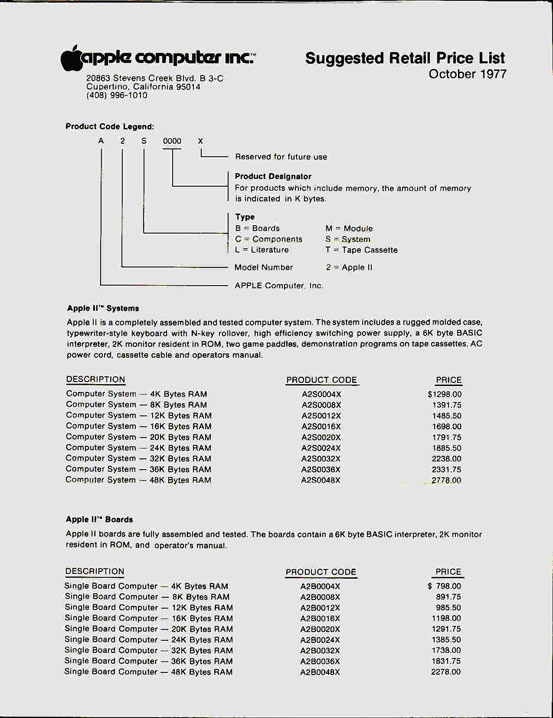
Friday, March 07. 2014
Scientists develop a lie detector for tweets
Via The Telegraph
-----

The Twitter logo displayed on a smart phone Photo: PA
Scientists have developed the ultimate lie detector for social media – a system that can tell whether a tweeter is telling the truth.
The creators of the system called Pheme, named after the Greek mythological figure known for scandalous rumour, say it can judge instantly between truth and fiction in 140 characters or less.
Researchers across Europe are joining forces to analyse the truthfulness of statements that appear on social media in “real time” and hope their system will prevent scurrilous rumours and false statements from taking hold, the Times reported.
The creators believe that the system would have proved useful to the police and authorities during the London Riots of 2011. Tweeters spread false reports that animals had been released from London Zoo and landmarks such as the London Eye and Selfridges had been set on fire, which caused panic and led to police being diverted.
Kalina Bontcheva, from the University of Sheffield’s engineering department, said that the system would be able to test information quickly and trace its origins. This would enable governments, emergency services, health agencies, journalists and companies to respond to falsehoods.
Thursday, February 06. 2014
DARPA - Open Catalog
 |
Open Catalog |
Welcome to the DARPA Open Catalog, which contains a curated list of DARPA-sponsored software and peer-reviewed publications. DARPA funds fundamental and applied research in a variety of areas including data science, cyber, anomaly detection, etc., which may lead to experimental results and reusable technology designed to benefit multiple government domains.
The DARPA Open Catalog organizes publically releasable material from DARPA programs, beginning with the XDATA program in the Information Innovation Office (I2O). XDATA is developing an open source software library for big data. DARPA has an open source strategy through XDATA and other I2O programs to help increase the impact of government investments.
DARPA is interested in building communities around government-funded software and research. If the R&D community shows sufficient interest, DARPA will continue to make available information generated by DARPA programs, including software, publications, data and experimental results. Future updates are scheduled to include components from other I2O programs such as Broad Operational Language Translation (BOLT) and Visual Media Reasoning (VMR).
The DARPA Open Catalog contains two tables:
- The Software Table lists performers with one row per piece of software. Each piece of software has a link to an external project page, as well as a link to the code repository for the project. The software categories are listed; in the case of XDATA, they are Analytics, Visualization and Infrastructure. A description of the project is followed by the applicable software license. Finally, each entry has a link to the publications from each team's software entry.
- The Publications Table contains author(s), title, and links to peer-reviewed articles related to specific DARPA programs.
Program Manager:
Dr. Christopher White
christopher.white@darpa.mil
-----
Monday, January 27. 2014
Lightbeam for Firefox
![]()
Lightbeam, a firefox plugin you may want to try... or not... in order to have an idea about what it means for you and your privacy to browse the Web. Nowadays, this is something obvious and well spread that the 'free' Web is now a very old chimera. Web drills you the same way one drills for oil.
Collusion is a similar plugin for the Chrome Web browser.
Enjoy!
Monday, November 25. 2013
Microsoft debuts 3D printing app for Windows 8.1
Via pcworld
-----
On Friday, Microsoft released its 3D Builder app, which allows Windows 8.1 users to print 3D objects, but not much else.
The simple, simplistic, free app from Microsoft provides a basic way to print common 3D objects, as well as to import other files from SkyDrive or elsewhere. But the degree of customization that the app allows is small, so 3D Builder basically serves as an introduction to the world of 3D printing.
In fact, that’s Microsoft’s intention, with demonstrations of the MakerBot Replicator 2 slated for Microsoft’s retails stores this weekend. Microsoft customers can buy a new Windows 8.1 PC, as well as the $2199 MakerBot Replicator 2, both online as well as in the brick-and-mortar stores themselves.
One of the selling points of Windows 8.1 was its ability to print 3D objects, a complement to traditional paper printing. Although Microsoft is pitching 3D Builder as a consumer app, the bulk of spending on 3D printing will come from businesses, which will account for $325 million out of the $415 million that will be spent this year on 3D printing, according to an October report from Gartner. However, 3D printers have made their way into Staples, and MakerBot latched onto an endorsement of the technology from President Obama during his State of the Union address, recently encouraging U.S. citizens to crowd-fund an effort to 3D printers in every high school in America. (MakerBot also announced a Windows 8.1 software driver on Thursday.)
 Microsoft
MicrosoftMicrosoft’s 3D Builder app could certainly be a part of that effort. Frankly, there’s little to the app itself besides a library of pre-selected objects, most of which seem to be built around small, unpowered model trains of the “Thomas the Tank Engine” variety. After selecting one, the user has the option of moving it around a 3D space, increasing or decreasing the size to a particular width or height—and not much else.
Users can also import models made elsewhere. Again, however, 3D Builder isn’t really designed to modify the designs. It’s also not clear which 3D formats are supported.
On the other hand, some might be turned off by the perceived complexity of 3D printing. If you have two grand to spend on a 3D printer but aren’t really sure how to use it, 3D Builder might be a good place to start.
Friday, November 22. 2013
Apple II DOS source code - The Computer History Museum Historical Source Code Series
-----
In June 1977 Apple Computer shipped their first mass-market computer:
the Apple II.
Unlike the Apple I, the Apple II was fully assembled and ready to use with any display monitor. The version with 4K of memory cost $1298. It had color, graphics, sound, expansion slots, game paddles, and a built-in BASIC programming language.
What it didn’t have was a disk drive. Programs and data had to be saved and loaded from cassette tape recorders, which were slow and unreliable. The problem was that disks – even floppy disks – needed both expensive hardware controllers and complex software.
Steve Wozniak solved the first problem. He designed an incredibly clever floppy disk controller using only 8 integrated circuits, by doing in programmed logic what other controllers did with hardware. With some rudimentary software written by Woz and Randy Wigginton, it was demonstrated at the Consumer Electronics Show in January 1978.
But where were they going to get the higher-level software to organize and access programs and data on the disk? Apple only had about 15 employees, and none of them had both the skills and the time to work on it.
The magician who pulled that rabbit out of the hat was Paul Laughton, a contract programmer for Shepardson Microsystems, which was located in the same Cupertino office park as Apple.
On April 10, 1978 Bob Shepardson and Steve Jobs signed a $13,000 one-page contract for a file manager, a BASIC interface, and utilities. It specified that “Delivery will be May 15?, which was incredibly aggressive. But, amazingly, “Apple II DOS version 3.1? was released in June 1978.
With thanks to Paul Laughton, in collaboration with Dr. Bruce Damer, founder and curator of the DigiBarn Computer Museum, and with the permission of Apple Inc., we are pleased to make available the 1978 source code of Apple II DOS for non-commercial use. This material is Copyright © 1978 Apple Inc., and may not be reproduced without permission from Apple.
There are seven files in this release that may be downloaded by clicking the hyperlinked filename on the left:
| Apple_DOS_2June1978.pdf | Scanned lineprinter listing from June 2, 1978 |
| Apple_DOS_6Oct1978.pdf | Scanned lineprinter listing from October 6, 1978 |
| Apple_DOS_6Oct1978_retyped.docx | Retyped source code of the October 6th version (This has not yet been assembled, and there may be some typographical errors.) |
| Apple_DOS_RW_30May1978.txt | The source code of the low-level read/write routines by Steve Wozniak and Randy Wigginton. |
| Apple_DOS_tech_docs.pdf | Various technical specifications and designs relating to the Apple II disk drive |
| Apple_DOS_contracts.pdf | Various contracts and addenda between Apple and Shepardson Microsystems |
| meeting_minutes_5Oct1978.pdf | Minutes of a meeting between Apple and Shepardson Microsystem about bugs and enhancements. (Unfortunately we don’t have the list that is referred to.) |
Friday, November 15. 2013
Wolfram: "Something Very Big Is Coming: Our Most Important Technology Project Yet"
Via Wolfram blog
-----
Computational knowledge. Symbolic programming. Algorithm automation. Dynamic interactivity. Natural language. Computable documents. The cloud. Connected devices. Symbolic ontology. Algorithm discovery. These are all things we’ve been energetically working on—mostly for years—in the context of Wolfram|Alpha, Mathematica, CDF and so on.
But recently something amazing has happened. We’ve figured out how to take all these threads, and all the technology we’ve built, to create something at a whole different level. The power of what is emerging continues to surprise me. But already I think it’s clear that it’s going to be profoundly important in the technological world, and beyond.
At some level it’s a vast unified web of technology that builds on what we’ve created over the past quarter century. At some level it’s an intellectual structure that actualizes a new computational view of the world. And at some level it’s a practical system and framework that’s going to be a fount of incredibly useful new services and products.
I have to admit I didn’t entirely see it coming. For years I have gradually understood more and more about what the paradigms we’ve created make possible. But what snuck up on me is a breathtaking new level of unification—that lets one begin to see that all the things we’ve achieved in the past 25+ years are just steps on a path to something much bigger and more important.

I’m not going to be able to explain everything in this blog post (let’s hope it doesn’t ultimately take something as long as A New Kind of Science
to do so!). But I’m excited to begin to share some of what’s been
happening. And over the months to come I look forward to describing some
of the spectacular things we’re creating—and making them widely
available.
It’s hard to foresee the ultimate consequences of what we’re doing. But the beginning is to provide a way to inject sophisticated computation and knowledge into everything—and to make it universally accessible to humans, programs and machines, in a way that lets all of them interact at a vastly richer and higher level than ever before.
A crucial building block of all this is what we’re calling the Wolfram Language.
In a sense, the Wolfram Language has been incubating inside Mathematica for more than 25 years. It’s the language of Mathematica, and CDF—and the language used to implement Wolfram|Alpha. But now—considerably extended, and unified with the knowledgebase of Wolfram|Alpha—it’s about to emerge on its own, ready to be at the center of a remarkable constellation of new developments.
We call it the Wolfram Language because it is a language. But it’s a new and different kind of language. It’s a general-purpose knowledge-based language. That covers all forms of computing, in a new way.
There are plenty of existing general-purpose computer languages. But their vision is very different—and in a sense much more modest—than the Wolfram Language. They concentrate on managing the structure of programs, keeping the language itself small in scope, and relying on a web of external libraries for additional functionality. In the Wolfram Language my concept from the very beginning has been to create a single tightly integrated system in which as much as possible is included right in the language itself.
And so in the Wolfram Language, built right into the language, are capabilities for laying out graphs or doing image processing or creating user interfaces or whatever. Inside there’s a giant web of algorithms—by far the largest ever assembled, and many invented by us. And there are then thousands of carefully designed functions set up to use these algorithms to perform operations as automatically as possible.
Over the years, I’ve put immense effort into the design of the language. Making sure that all the different pieces fit together as smoothly as possible. So that it becomes easy to integrate data analysis here with document generation there, with mathematical optimization somewhere else. I’m very proud of the results—and I know the language has been spectacularly productive over the course of a great many years for a great many people.
But now there’s even more. Because we’re also integrating right into the language all the knowledge and data and algorithms that are built into Wolfram|Alpha. So in a sense inside the Wolfram Language we have a whole computable model of the world. And it becomes trivial to write a program that makes use of the latest stock price, computes the next high tide, generates a street map, shows an image of a type of airplane, or a zillion other things.
We’re also getting the free-form natural language of Wolfram|Alpha. So when we want to specify a date, or a place, or a song, we can do it just using natural language. And we can even start to build up programs with nothing more than natural language.
There are so many pieces. It’s quite an array of different things.
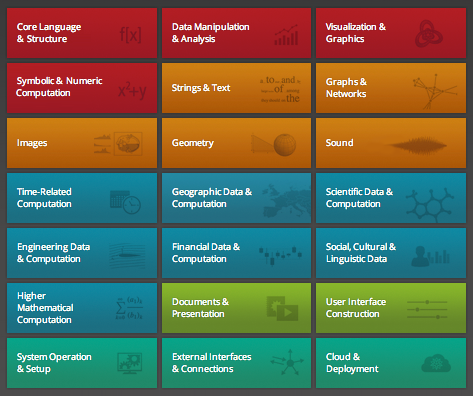
But what’s truly remarkable is how they assemble into a unified whole.
Partly that’s the result of an immense amount of work—and discipline—in the design process over the past 25+ years. But there’s something else too. There’s a fundamental idea that’s at the foundation of the Wolfram Language: the idea of symbolic programming, and the idea of representing everything as a symbolic expression. It’s been an embarrassingly gradual process over the course of decades for me to understand just how powerful this idea is. That there’s a completely general and uniform way to represent things, and that at every level that representation is immediately and fluidly accessible to computation.
It can be an array of data. Or a piece of graphics. Or an algebraic formula. Or a network. Or a time series. Or a geographic location. Or a user interface. Or a document. Or a piece of code. All of these are just symbolic expressions which can be combined or manipulated in a very uniform way.
But in the Wolfram Language, there’s not just a framework for setting up these different kinds of things. There’s immense built-in curated content and knowledge in each case, right in the language. Whether it’s different types of visualizations. Or different geometries. Or actual historical socioeconomic time series. Or different forms of user interface.
I don’t think any description like this can do the concept of symbolic programming justice. One just has to start experiencing it. Seeing how incredibly powerful it is to be able to treat code like data, interspersing little programs inside a piece of graphics, or a document, or an array of data. Or being able to put an image, or a user interface element, directly into the code of a program. Or having any fragment of any program immediately be runnable and meaningful.
In most languages there’s a sharp distinction between programs, and data, and the output of programs. Not so in the Wolfram Language. It’s all completely fluid. Data becomes algorithmic. Algorithms become data. There’s no distinction needed between code and data. And everything becomes both intrinsically scriptable, and intrinsically interactive. And there’s both a new level of interoperability, and a new level of modularity.
So what does all this mean? The idea of universal computation implies that in principle any computer language can do the same as any other. But not in practice. And indeed any serious experience of using the Wolfram Language is dramatically different than any other language. Because there’s just so much already there, and the language is immediately able to express so much about the world. Which means that it’s immeasurably easier to actually achieve some piece of functionality.
I’ve put a big emphasis over the years on automation. So that the Wolfram Language does things automatically whenever you want it to. Whether it’s selecting an optimal algorithm for something. Or picking the most aesthetic layout. Or parallelizing a computation efficiently. Or figuring out the semantic meaning of a piece of data. Or, for that matter, predicting what you might want to do next. Or understanding input you’ve given in natural language.
Fairly recently I realized there’s another whole level to this. Which has to do with the actual deployment of programs, and connectivity between programs and devices and so on. You see, like everything else, you can describe the infrastructure for deploying programs symbolically—so that, for example, the very structure and operation of the cloud becomes data that your programs can manipulate.
And this is not just a theoretical idea. Thanks to endless layers of software engineering that we’ve done over the years—and lots of automation—it’s absolutely practical, and spectacular. The Wolfram Language can immediately describe its own deployment. Whether it’s creating an instant API, or putting up an interactive web page, or creating a mobile app, or collecting data from a network of embedded programs.
And what’s more, it can do it transparently across desktop, cloud, mobile, enterprise and embedded systems.
It’s been quite an amazing thing seeing this all start to work. And being able to create tiny programs that deploy computation across different systems in ways one had never imagined before.
This is an incredibly fertile time for us. In a sense we’ve got a new paradigm for computation, and every day we’re inventing new ways to use it. It’s satisfying, but more than a little disorienting. Because there’s just so much that is possible. That’s the result of the unique convergence of the different threads of technology that we’ve been developing for so long.
Between the Wolfram Language—with all its built-in computation and knowledge, and ways to represent things—and our Universal Deployment System, we have a new kind of universal platform of incredible power. And part of the challenge now is to find the best ways to harness it.
Over the months to come, we’ll be releasing a series of products that support particular ways of using the Wolfram Engine and the Universal Platform that our language and deployment system make possible.
There’ll be the Wolfram Programming Cloud, that allows one to create Wolfram Language programs, then instantly deploy them in the cloud through an instant API, or a form-based app, or whatever. Or deploy them in a private cloud, or, for example, through a Function Call Interface, deploy them standalone in desktop programs and embedded systems. And have a way to go from an idea to a fully deployed realization in an absurdly short time.
There’ll be the Wolfram Data Science Platform, that allows one to connect to all sorts of data sources, then use the kind of automation seen in Wolfram|Alpha Pro, then pick out and modify Wolfram Language programs to do data science—and then use CDF to set up reports to generate automatically, on a schedule, through an API, or whatever.
There’ll be the Wolfram Publishing Platform that lets you create documents, then insert interactive elements using the Wolfram Language and its free-form linguistics—and then deploy the documents, on the web using technologies like CloudCDF, that instantly support interactivity in any web browser, or on mobile using the Wolfram Cloud App.
And we’ll be able to advance Mathematica a lot too. Like there’ll be Mathematica Online, in which a whole Mathematica session runs on the cloud through a web browser. And on the desktop, there’ll be seamless integration with the Wolfram Cloud, letting one have things like persistent symbolic storage, and instant large-scale parallelism.
And there’s still much more; the list is dauntingly long.
Here’s another example. Just as we curate all sorts of data and algorithms, so also we’re curating devices and device connections. So that built into the Wolfram Language, there’ll be mechanisms for communicating with a very wide range of devices. And with our Wolfram Embedded Computation Platform, we’ll have the Wolfram Language running on all sorts of embedded systems, communicating with devices, as well as with the cloud and so on.
At the center of everything is the Wolfram Language, and we intend to make this as widely accessible to everyone as possible.
The Wolfram Language is a wonderful first language to learn (and we’ve done some very successful experiments on this). And we’re planning to create a Programming Playground that lets anyone start to use the language—and through the Programming Cloud even step up to make some APIs and so on for free.
We’ve also been building the Wolfram Course Authoring Platform, that does major automation of the process of going from a script to all the elements of an online course—then lets one deploy the course in the cloud, so that students can have immediate access to a Wolfram Language sandbox, to be able to explore the material in the course, do exercises, and so on. And of course, since it’s all based on our unified system, it’s for example immediate that data from the running of the course can go into the Wolfram Data Science Platform for analysis.
I’m very excited about all the things that are becoming possible. As the Wolfram Language gets deployed in all these different places, we’re increasingly going to be able to have a uniform symbolic representation for everything. Computation. Knowledge. Content. Interfaces. Infrastructure. And every component of our systems will be able to communicate with full semantic fidelity, exchanging Wolfram Language symbolic expressions.
Just as the lines between data, content and code blur, so too will the lines between programming and mere input. Everything will become instantly programmable—by a very wide range of people, either by using the Wolfram Language directly, or by using free-form natural language.
There was a time when every computer was in a sense naked—with just its basic CPU. But then came things like operating systems. And then various built-in languages and application programs. What we have now is a dramatic additional step in this progression. Because with the Wolfram Language, we can in effect build into our computers a vast swath of existing knowledge about computation and about the world.
If we’re forming a kind of global brain with all our interconnected computers and devices, then the Wolfram Language is the natural language for it. Symbolically representing both the world and what can be created computationally. And, conveniently enough, being efficient and understandable for both computers and humans.
The foundations of all of this come from decades spent on Mathematica, and Wolfram|Alpha, and A New Kind of Science. But what’s happening now is something new and unexpected. The emergence, in effect, of a new level of computation, supported by the Wolfram Language and the things around it.
So far I can see only the early stages of what this will lead to. But already I can tell that what’s happening is our most important technology project yet. It’s a lot of hard work, but it’s incredibly exciting to see it all unfold. And I can’t wait to go from “Coming Soon” to actual systems that people everywhere can start to use…
Sunday, November 03. 2013
Watch 15 Awesome MS-DOS Viruses in Action
Via Wired
-----
-
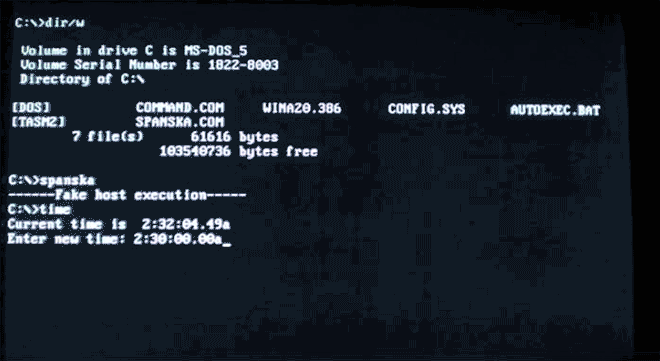 Elvira, virus by French programmer Spanska, replicated the Star Wars opening crawl in an ode to his girlfriend. Image: danooct1
Elvira, virus by French programmer Spanska, replicated the Star Wars opening crawl in an ode to his girlfriend. Image: danooct1 -
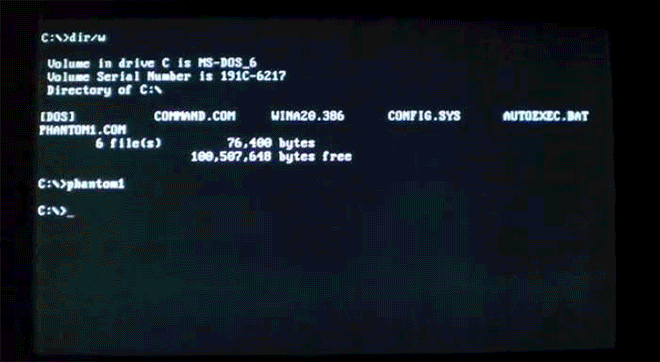 Virus.DOS.Phantom1 is menacing--but also clearly a labor of love. Image: danooct1
Virus.DOS.Phantom1 is menacing--but also clearly a labor of love. Image: danooct1 -
 Virus.DOS.Walker displays a crude bit of 8-bit porno (not shown) and then has an old man stroll across your screen. Image: danooct1
Virus.DOS.Walker displays a crude bit of 8-bit porno (not shown) and then has an old man stroll across your screen. Image: danooct1 -
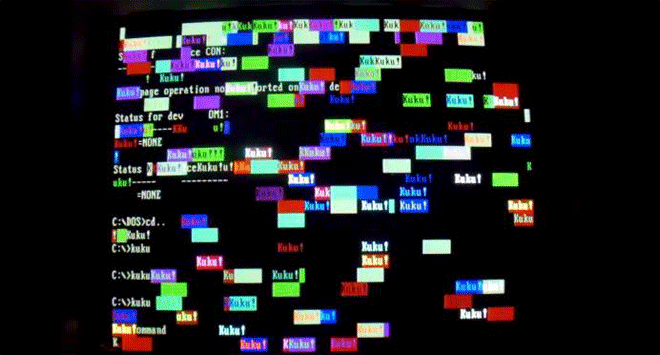 Virus.DOS.Kuku infects all EXE and COM files, and, one time out of eight, displays this lovely colorful confetti on your screen. Image: danooct1
Virus.DOS.Kuku infects all EXE and COM files, and, one time out of eight, displays this lovely colorful confetti on your screen. Image: danooct1 -
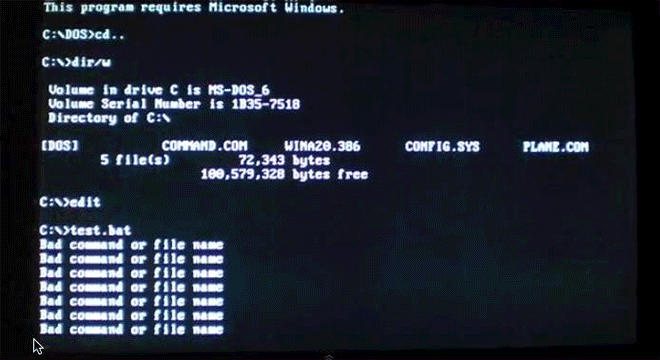 Virus.DOS.Plane unleashes a parachuter on your command line, creating infected companion files for COMs and EXEs. Image: danooct1
Virus.DOS.Plane unleashes a parachuter on your command line, creating infected companion files for COMs and EXEs. Image: danooct1 -
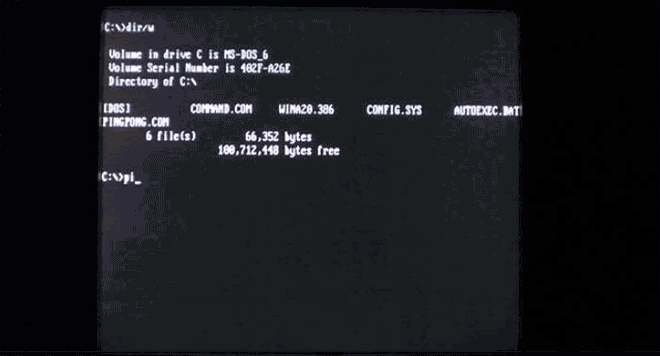 Virus.Boot.Pingpong doesn't destroy anything, but it does turn your screen into a game of ping pong (but only if you try to run files on the half hour [seriously]). Image: danooct1
Virus.Boot.Pingpong doesn't destroy anything, but it does turn your screen into a game of ping pong (but only if you try to run files on the half hour [seriously]). Image: danooct1 -
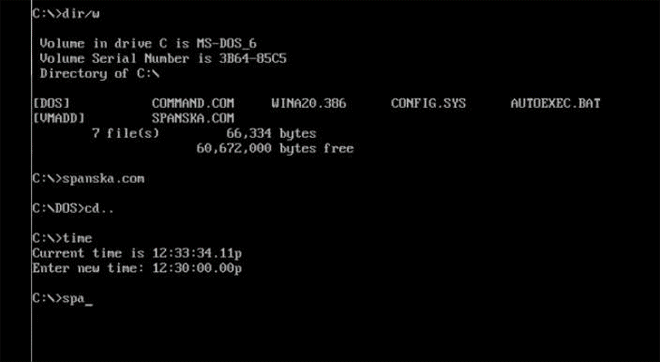 "Mars Land," another one of Spanksa's viruses, shows a lovely lava flow with a nice message: Coding a virus can be creative. Image: danooct1
"Mars Land," another one of Spanksa's viruses, shows a lovely lava flow with a nice message: Coding a virus can be creative. Image: danooct1 -
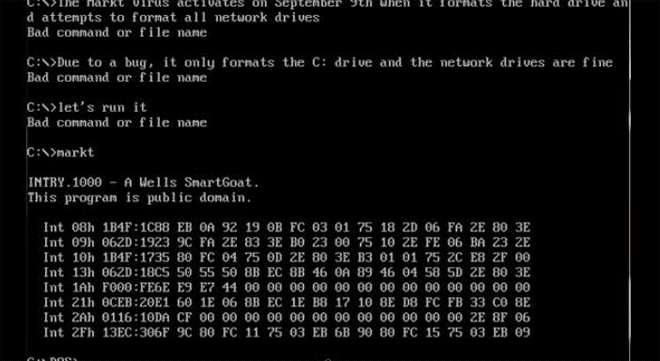 Markt DOS Virus looks scary--and it is: it formats your entire C drive. Image: danooct1
Markt DOS Virus looks scary--and it is: it formats your entire C drive. Image: danooct1 -
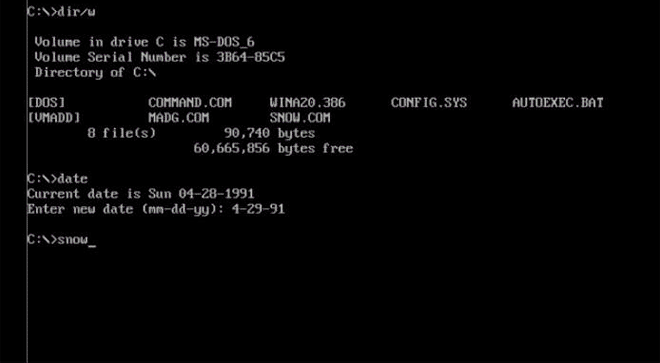 Ithaqua DOS Virus is just plain nice. Every April 29 it takes over your screen to show a gentle snowfall. Image: danooct1
Ithaqua DOS Virus is just plain nice. Every April 29 it takes over your screen to show a gentle snowfall. Image: danooct1 -
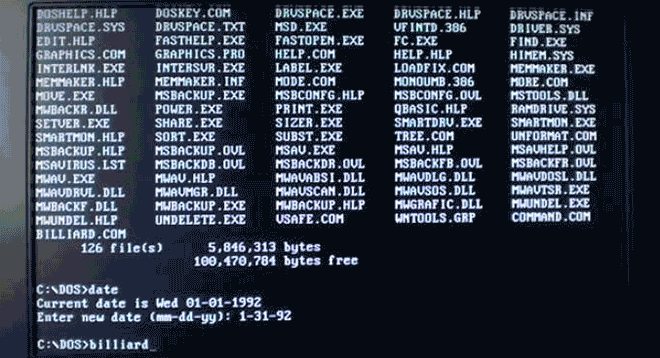 Virus.DOS.Billiards turns your boring text into a colorful game of pool. Nice! Image: danooct1
Virus.DOS.Billiards turns your boring text into a colorful game of pool. Nice! Image: danooct1 -
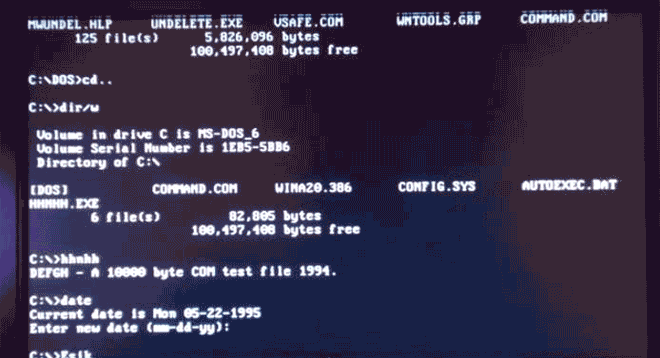 Virus.DOS.HHnHH, a bouncing particle ball, wouldn't make a bad screensaver. Image: danooct1
Virus.DOS.HHnHH, a bouncing particle ball, wouldn't make a bad screensaver. Image: danooct1 -
 Apple DOS Trojan proves that even in the underground world of DOS viruses, fanboys were fanboys. Image: danooct1
Apple DOS Trojan proves that even in the underground world of DOS viruses, fanboys were fanboys. Image: danooct1 -
 PlayGame DOS Virus makes the unfortunate user play a game upon booting up, but only in December. Image: danooct1
PlayGame DOS Virus makes the unfortunate user play a game upon booting up, but only in December. Image: danooct1 -
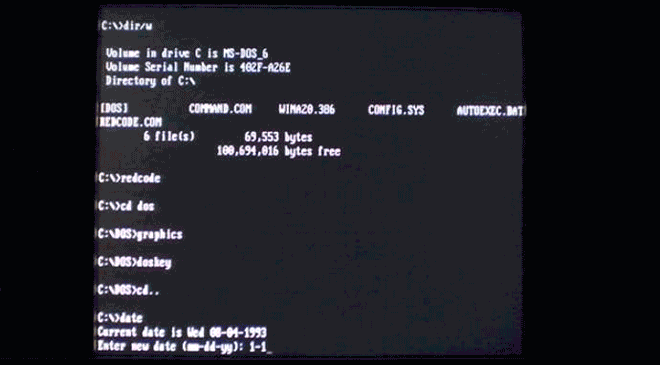 Virus.DOS.Redcode plays out a little race between Big Butt Gasso and Himmler Fewster. Weird. Image: danooct1
Virus.DOS.Redcode plays out a little race between Big Butt Gasso and Himmler Fewster. Weird. Image: danooct1 -
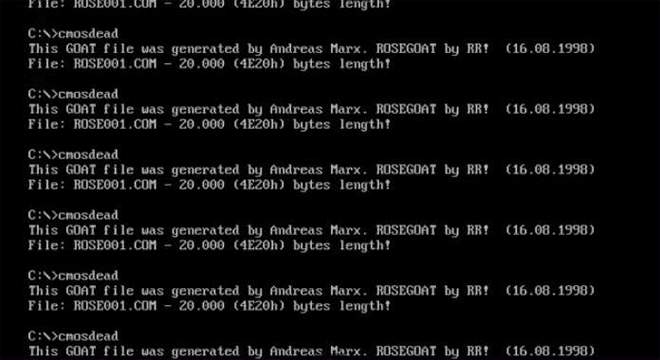 CMOS DOS Virus is an evil virus indeed. Along with this seizure-inducing payload (and a shrieking beeping noise), it corrupts the CMOS memory, wiping all sorts of settings. The most diabolical bit? If you try to press Control Alt Delete, it reformats your whole hard drive. Image: danooct1
CMOS DOS Virus is an evil virus indeed. Along with this seizure-inducing payload (and a shrieking beeping noise), it corrupts the CMOS memory, wiping all sorts of settings. The most diabolical bit? If you try to press Control Alt Delete, it reformats your whole hard drive. Image: danooct1
Back in 2004, a computer worm called Sasser swept across the web, infecting an estimated quarter million PCs. One of them belonged to Daniel White, then 16 years old. In the course of figuring out how to purge the worm from his system, the teenager came across the website of anti-virus company F-Secure, which hosted a vast field guide of malware dating back to the 1980s, complete with explanations, technical write-ups, and even screenshots for scores of antiquated viruses. He found it intoxicating. “I just read all I could,” he says, “and when I’d read all of that I found more sources to read.” He’d caught the computer virus bug.
Nine years and a handful of data loss scares later, White has amassed perhaps the most comprehensive archive of malware-in-action found anywhere on the web. His YouTube channel, which he started in 2008, includes more than 450 videos, each dedicated to documenting the effect of some old, outdated virus. The contents span decades, stretching from the dawn of personal computing to the heyday of Windows in the late ’90s. It’s a fascinating cross-section of the virus world, from benign programs that trigger goofy, harmless pop-ups to malicious, hell-raising bits of code. Happening across one of White’s clips for a virus you’ve done battle with back in the day can be a surprisingly nostalgic experience.
But while the recent Windows worms may be the most familiar, another subset of White’s archive is even more interesting. The viruses he’s collected from the MS-DOS era are malware from a simpler time–a glimpse into a largely forgotten and surprisingly creative subculture.
“In the DOS era it was very much a hobbyist sort of thing,” White explains. Skilled coders wanted to show off their skills. They formed groups, and those groups pioneered different ways to infect and proliferate. A community coalesced around bulletin boards and newsgroups. Techniques were exchanged; rivalries bubbled up. For many writers, though, a successful virus didn’t necessarily mean messing up someone’s computer–or even letting users know that they’d been infected in the first place. Quietly, virus writers amassed invisible, harmless networks as testaments to their chops. “Not all authors were complete dicks,” White says. “There were far more viruses that only infected files and continued spreading than there were viruses that damaged data or displayed ‘gotcha’ messages.”
As we see here, though, some of those “gotcha” messages–a virus’ payload, as it’s called–were spectacularly unique. Amidst the dull monochromatic world of the command line, these viruses exploded to life. One, created by the French virus writer Spanska, flooded an infected machine’s display with a dramatic flow of digital lava. Another showed a menacing skull, clearly rendered with patience and care. Others were more playful: a billiards-themed virus turned command line text into a colorful game of pool, with letters bouncing around the display and knocking others along the way. Some were downright sweet. The Ithaqua DOS virus showed a gentle, pixelated snowfall accumulating on the infected machine’s screen–and only on one day a year.
For at least some of these mischievous coders, the virus truly did serve as a creative medium. When asked about his view on destructive code in a 1997 interview, Spanska, the French lava master, replied: “I really do not like that…There are two principal reasons why I will never put a destructive code inside one my viruses. First, I respect other peoples’ work…The second reason is that a destructive payload is too easy to code. Formatting a HD? Twenty lines of assembler, coded in one minute. Deleting a file? Five instructions. Written in one second. Easy things are not interesting for the coder. I prefer to spend weeks to code a beautiful VGA effect. I prefer create than destruct [sic]. It’s so important for me that I put this phrase in my MarsLand virus: ‘Coding a virus can be creative.’”
Of course, no matter how widely they might’ve spread in the weeks and months following their deployment, these old viruses were inevitably squelched. Systems were patched and upgrades rendered their exploits obsolete. Even the F-Secure database that sparked his obsession is largely inaccessible today, White points out, discarded in favor of a “more ‘consumer friendly’ website.” So White resolutely keeps on preserving the things–infecting virtual machines and filming the results. Now a graduate student specializing in satellite imaging systems, he still finds time to upload a new video every month or so, often working with files that tipsters send him to fill in holes in his collection. Thankfully for him and his hardware, the hobby isn’t quite as risky as you might think. “For the most part, the stuff I handle won’t do much of anything, if anything at all, on modern PCs and operating systems,” he says. But you never know. “I live by the philosophy ‘if you’re not willing to lose all the data on every PC on the network, don’t start toying with malware.’”
Wednesday, October 30. 2013
Facebook may start tracking your cursor as you browse the site
Via The Verge
-----

For some time Facebook has studied your Likes, comments, and clicks to help create better ads and new products, but soon, the company might also track the location of your cursor on screen. Facebook analytics chief Ken Rudin told The Wall Street Journal about several new measures the company is testing meant to help improve its user-tracking, like seeing how long you hover your cursor over an ad (and if you click it), and evaluating if certain elements on screen are within view or are off the page. New data gathered using these methods could help Facebook create more engaging News Feed layouts and ads.
The Journal notes that this kind of tracking is hardly uncommon, but until now, Facebook hadn't gone this deep in its behavioral data measurement. Sites like Shutterstock, for example, track how long users hover their cursors over an image before deciding to buy it. Facebook is famous for its liberal use of A/B testing to try out new products on consumers, but it's using the same method to judge the efficacy of its new testing methods. "Facebook should know within months whether it makes sense to incorporate the new data collection into the business," reports the Journal.
Assuming Facebook's tests go well, it shouldn't be long before our every flinch is tracked on the site. So what might come next? Our eyeballs.
Monday, October 21. 2013
This Crazy Program Turns Wikipedia Into 3D Models of the Real World
Via Gizmodo
----
Google puts a lot of work into creating a virtual map of the world with Street View, sending cars and backpackers everywhere with huge cameras. But what if a computer program could do all that automatically? Well, there's one that can. All it needs is Wikipedia and Google Images.
Developed by Bryan Russell at Intel Labs and some colleagues at the University of Washington in Seattle, the program is almost deceptively simple. First, it trawls the internet (mainly Flickr) for a wide variety of pictures of a location. By looking at them from different angles, it's able to piece together a pretty good idea of what it looks like in 3D space from the outside. Like this:
Then, for the interior of that 3D shell, the program cruises through Wikipedia, making note of every single noun-phrase, since its dumb robot brain can't tell what is important and what is not. Finally, it searches Google Images for its big stack of phrases, pulls the relevant pictures (if it can find any), and plasters them roughly where they belong in the model's interior. When that's all said and done, it can then behave as a procedurally generated 3D tour that guides you through a recreation of whatever you're reading about on Wikipedia. Awesome!
It's a crazy idea, but it seems to work pretty well for popular landmarks, at least. The operating logic here is that if a thing is important, there will be pictures of it on the internet, and text describing the pictures. So long as that's true, it's possible to start piecing things together.
For the moment, the program has only compiled complete virtual representations of exceedingly popular and well-documented sites like the Sistine Chapel. With less common places, there's less data to pull. But with the advent of tech like Google Glass, and the wide proliferation of smartphones that can take a half-decent picture, the data-voids are slowly getting filled in—and they'll only fill in faster as time goes on.
So if you ever needed a great reason to keep all your vacation pictures public and publicly indexed, here it is. [Bryan C. Russell via New Scientist]
Wednesday, October 16. 2013
What Big Data Knows About Us
Via Mashable
-----


The world of Big Data is one of pervasive data collection and aggressive analytics. Some see the future and cheer it on; others rebel. Behind it all lurks a question most of us are asking — does it really matter? I had a chance to find out recently, as I got to see what Acxiom, a large-scale commercial data aggregator, had collected about me.
At least in theory large-scale data collection matters quite a bit. Large data sets can be used to create social network maps and can form the seeds for link analysis of connections between individuals. Some see this as a good thing; others as a bad one — but whatever your viewpoint, we live in a world which sees increasing power and utility in Big Data’s large-scale data sets.
Of course, much of the concern is about government collection. But it’s difficult to assess just how useful this sort of data collection by the government is because, of course, most governmental data collection projects are classified. The good news, however, is that we can begin to test the utility of the program in the private sector arena. A useful analog in the private sector just became publicly available and it’s both moderately amusing and instructive to use it as a lens for thinking about Big Data.
Acxiom is one of the largest commercial, private sector data aggregators around. It collects and sells large data sets about consumers — sometimes even to the government. And for years it did so quietly, behind the scene — as one writer put it “mapping the consumer genome.” Some saw this as rather ominous; others as just curious. But it was, for all of us, mysterious. Until now.
In September, the data giant made available to the public a portion of its data set. They created a new website — Abouthedata.com — where a consumer could go to see what data the company had collected about them. Of course, in order to access the data about yourself you had to first verify your own identity (I had to send in a photocopy of my driver’s license), but once you had done so, it would be possible to see, in broad terms, what the company thought it knew about you — and how close that knowledge was to reality.
I was curious, so I thought I would go explore myself and see what it was they knew and how accurate they were. The results were at times interesting, illuminating and mundane. Here are a few observations:
To begin with, the fundamental purpose of the data collection is to sell me things — that’s what potential sellers want to know about potential buyers and what, say, Amazon might want to know about me. So I first went and looked at a category called “Household Purchase Data” — in other words what I had recently bought.
It turns out that I buy … well … everything. I buy food, beverages, art, computing equipment, magazines, men’s clothing, stationary, health products, electronic products, sports and leisure products, and so forth. In other words, my purchasing habits were, to Acxiom, just an undifferentiated mass. Save for the notation that I had bought an antique in the past and that I have purchased “High Ticket Merchandise,” it seems that almost everything I bought was something that most any moderately well-to-do consumer would buy.
I do suppose that the wide variety of purchases I made is, itself, the point — by purchasing so widely I self-identify as a “good” consumer. But if that’s the point then the data set seems to miss the mark on “how good” I really am. Under the category of “total dollars spent,” for example, it said that I had spent just $1,898 in the past two years. Without disclosing too much about my spending habits in this public forum, I think it is fair to say that this is a significant underestimate of my purchasing activity.
The next data category of “Household Interests” was equally unilluminating. Acxiom correctly said I was interested in computers, arts, cooking, reading and the like. It noted that I was interested in children’s items (for my grandkids) and beauty items and gardening (both my wife’s interest, probably confused with mine). Here, as well, there was little differentiation, and I assume the breadth of my interests is what matters rather that the details. So, as a consumer, examining what was collected about me seemed to disclose only a fairly anodyne level of detail.
[Though I must object to the suggestion that I am an Apple user J. Anyone who knows me knows I prefer the Windows OS. I assume this was also the result of confusion within the household and a reflection of my wife’s Apple use. As an aside, I was invited throughout to correct any data that was in error. This I chose not to do, as I did not want to validate data for Acxiom – that’s their job not mine—and I had no real interest in enhancing their ability to sell me to other marketers. On the other hand I also did not take the opportunity they offered to completely opt-out of their data system, on the theory that a moderate amount of data in the world about me may actually lead to being offered some things I want to purchase.]
Things became a bit more intrusive (and interesting) when I started to look at my “Characteristic Data” — that is data about who I am. Some of the mistakes were a bit laughable — they pegged me as of German ethnicity (because of my last name, naturally) when, with all due respect to my many German friends, that isn’t something I’d ever say about myself. And they got my birthday wrong — lord knows why.
But some of their insights were at least moderately invasive of my privacy, and highly accurate. Acxiom “inferred” for example, that I’m married. They identified me accurately as a Republican (but notably not necessarily based on voter registration — instead it was the party I was “associated with by voter registration or as a supporter”). They knew there were no children in my household (all grown up) and that I run a small business and frequently work from home. And they knew which sorts of charities we supported (from surveys, online registrations and purchasing activity). Pretty accurate, I’d say.
Finally, it was completely unsurprising that the most accurate data about me was closely related to the most easily measurable and widely reported aspect of my life (at least in the digital world) — namely, my willingness to dive into the digital financial marketplace.
Acxiom knew that I had several credit cards and used them regularly. It had a broadly accurate understanding of my household total income range [I’m not saying!].Acxiom knew that I had several credit cards and used them regularly.
They also knew all about my house — which makes sense since real estate and liens are all matters of public record. They knew I was a home owner and what the assessed value was. The data showed, accurately, that I had a single family dwelling and that I’d lived there longer than 14 years. It disclosed how old my house was (though with the rather imprecise range of having been built between 1900 and 1940). And, of course, they knew what my mortgage was, and thus had a good estimate of the equity I had in my home.
So what did I learn from this exercise?
In some ways, very little. Nothing in the database surprised me, and the level of detail was only somewhat discomfiting. Indeed, I was more struck by how uninformative the database was than how detailed it was — what, after all, does anyone learn by knowing that I like to read? Perhaps Amazon will push me book ads, but they already know I like to read because I buy directly from them. If they had asserted that I like science fiction novels or romantic comedy movies, that level of detail might have demonstrated a deeper grasp of who I am — but that I read at all seems pretty trivial information about me.
I do, of course, understand that Acxiom has not completely lifted the curtains on its data holdings. All we see at About The Data is summary information. You don’t get to look at the underlying data elements. But even so, if that’s the best they can do ….
In fact, what struck me most forcefully was (to borrow a phrase from Hannah Arendt) the banality of it all. Some, like me, see great promise in big data analytics as a way of identifying terrorists or tracking disease. Others, with greater privacy concerns, look at big data and see Big Brother. But when I dove into one big data set (albeit only partially), held by one of the largest data aggregators in the world, all I really became was a bit bored.
Maybe that’s what they wanted as a way of reassuring me. If so, Acxiom succeeded, in spades.
Quicksearch
Popular Entries
- The great Ars Android interface shootout (130641)
- Norton cyber crime study offers striking revenue loss statistics (100819)
- MeCam $49 flying camera concept follows you around, streams video to your phone (99573)
- Norton cyber crime study offers striking revenue loss statistics (57048)
- The PC inside your phone: A guide to the system-on-a-chip (56934)
Categories
Show tagged entries
Syndicate This Blog
Calendar
|
|
December '25 | |||||
| Mon | Tue | Wed | Thu | Fri | Sat | Sun |
| 1 | 2 | 3 | 4 | 5 | 6 | 7 |
| 8 | 9 | 10 | 11 | 12 | 13 | 14 |
| 15 | 16 | 17 | 18 | 19 | 20 | 21 |
| 22 | 23 | 24 | 25 | 26 | 27 | 28 |
| 29 | 30 | 31 | ||||
